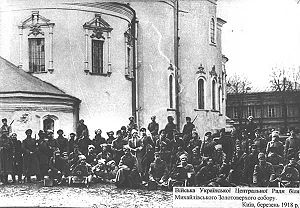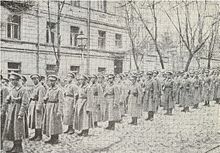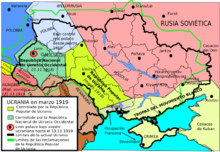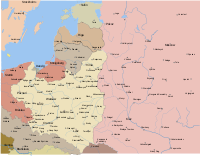- Ukrainian–Soviet War
-
Ukrainian–Soviet War Part of Ukrainian War of Independence and the Russian Civil War 
Soldiers of the UNR Army in front of St. Michael's Golden-Domed Monastery in Kiev.Date 1917–1921 Location Ukraine Result Bolshevik victory Territorial
changesIncorporation of most of Ukraine into the Ukrainian Soviet Socialist Republic and the Union of Soviet Socialist Republics Belligerents  Ukrainian People's Republic
Ukrainian People's Republic Russian Soviet Federative Socialist Republic
Russian Soviet Federative Socialist Republic
 Ukrainian Soviet Socialist Republic
Ukrainian Soviet Socialist RepublicCommanders and leaders Symon Petliura
Pavlo Skoropadsky
Mykhailo Pavlenko
Oleksandr UdovychenkoGeorgiy Pyatakov
Volodymyr Zatonsky
Mikhail Muraviev
Nikolay ShchorsStrength 300,000 at their peak[1] History of Ukraine 
This article is part of a series- Cassette Scandal
- Orange Revolution
- Russia–Ukraine gas disputes
The Ukrainian–Soviet War[2] of 1917–21 (Ukrainian: Українсько-радянська війна) was a military conflict between the Ukrainian People's Republic and pro-Bolshevik forces for the control of Ukraine after the dissolution of the Russian Empire.
Contents
Background
See also: Treaty of Brest-LitovskThe February Revolution of 1917 caused the many ethnic groups in the Russian republic to demand greater autonomy from Petrograd and various degrees of self-determination. A month later the Ukrainian People's Republic was declared in Kiev as an autonomous entity with close ties to the Russian Provisional Government, governed by the Tsentralna Rada. However, the October Revolution caused the Russian Empire to disintegrate completely. In late December 1917, Bolsheviks set up a rival Ukrainian government in Kharkiv, called the Ukrainian Soviet Socialist Republic and began hostilities against the government in Kiev. Following this, the Rada broke ties with Petrograd on January 22, 1918, and declared Ukrainian independence, thereby commencing the Ukrainian War of Independence.[3][4] It was around this point that Bolshevik troops began invading Ukraine from Russia.[5] Russian military units from Kharkiv, Moscow, Minsk and the Baltic Fleet invaded Ukraine.[6]
The war
December 1917 to April 1918
See also: Kiev Bolshevik Uprising and Kiev Arsenal January UprisingThe Bolsheviks, numbering around 30,000 and composed of Russian army regulars stationed at the front, a number of garrisoned units, and Red Guard detachments composed of laborers from Kharkov gubernia and the Donbass, began by advancing from the northeast led by Vladimir Antonov-Ovseenko and Mikhail Muravyov.[7] The Ukrainian forces at the time of the invasion consisted of about 15,000 made up from volunteer detachments and several battalions of the Free Cossacks and the Sich Riflemen.
The invasion of pro-Soviet forces from Russia was accompanied by uprisings initiated in Ukraine by the local Bolshevik agitators in the developed cities throughout the territory of Left-bank Ukraine as well as Right-bank Ukraine. The Bolshevik led by Yevgenia Bosch conducted a successful uprising in Vinnytsia sometime in December 1917. They took charge of the 2nd Guard Corps and moved towards Kiev to help the bolshevik agitators in the city. Pavlo Skoropadsky with a regiment of the Free Cossacks managed to stop them near Zhmerynka, disarm them, and deport them to Russia. The other Bolshevik forces captured Kharkiv (December 26), Yekaterinoslav, (January 9), Aleksandrovsk (January 15), and Poltava (January 20) on their way to Kiev. On January 27, the Bolshevik army groups converged in Bakhmach and then set off under the command of Muravyov to take Kiev.[2]
As the Bolsheviks marched towards Kiev, a small Ukrainian National Republic unit of less than 500 schoolboys (some sources give a figure of 300[8]), commanded by Captain Ahapiy Honcharenko, was hastily organized and sent to the front on January 29, 1918 to take part in the Battle of Kruty. The small unit consisted mainly of the Student Battalion (Kurin) of Sich Riflemen, a unit of the Khmelnytsky Cadet School, and a Haidamaka detachment. About half of the 500 men were killed during the battle.
Also on January 29, 1918, the Kiev Arsenal January Uprising, a Bolshevik organized armed revolt, began at the Kiev Arsenal factory. On February 8 the Ukrainian government was forced to evacuate the city in order to save it from destruction. Soviet troops under Mikhail Muravyov's command entered Kiev on February 9 and then carried out brutal reprisals against the Ukrainian civilian population,[2] killing as many as 4000 civilians.[7]
Once the Bolsheviks took Kiev, they began an offensive in Right-Bank Ukraine. However, on February 9 the UNR signed the Treaty of Brest-Litovsk and thus received aid from German and Austrian troops in late February, over 450,000 troops.[5] In exchange for military aid, the Ukrainians were to deliver foodstuffs to the Central Powers.[5] Under the command of Symon Petlura, the combined forces pushed the Bolsheviks out of Right Bank Ukraine and retook Kiev on March 1. Because of the socialist policies of the Rada, mainly the policy of land nationalization which affected food exports to the Central Powers, on April 28 the German forces disbanded the Tsentralna Rada and installed the Hetman government in its place. Ukrainian, German, and Austrian armies continued making gains, taking back Left Bank Ukraine, Crimea and the Donets Basin. These setbacks forced the Bolsheviks to sign a peace treaty with the Ukrainian government on June 12.
Post Hetmanate Intervention
During November 1918, troops from the Directorate of Ukraine overthrew the Hetmanate with some help from the Bolsheviks. German forces led by the Soldatenrat kept their neutrality during the two-week-long civil war as they were withdrawing from the country, due to the defeat of the German Empire in the World War I. The Direcotry reestablished the Ukrainian People's Republic. On January 22, 1919 the neighboring Ukrainian Republics united under the Act Zluky. During that time the Bolsheviks invaded Ukraine at full force[9] with an army led by Vladimir Antonov-Ovsiyenko, Joseph Stalin, and Volodymyr Zatonsky.[2] The Directory declared war once again against Russia on January 16 after several preliminary ultimatums to the Russian SFSR sovnarkom to withdraw their troops. The two main directions of the Bolshevik's forces were onto Kiev and Kharkiv. To stop the war the government of Chekhivsky sent a delegation to Moscow led by the Minister of Foreign Affairs Semen Mazurenko. The delegation succeeded in signing the preliminary peaceful agreement yet it did not stop the aggression from the Russian side due to poor communication between the delegation in Moscow and the government of the Ukrainian People's Republic.[10] On December 28, 1918 the Central Committee of the Left UPSR officially declared about the mobilization of force in the support of the Soviet government by an armed staging. From the beginning of January 1919 the Bolshevik bands consistently were crossing the eastern and north-eastern borders for purpose of raids.
The Central Military-Revolutionary Committee in Kursk on October 22, 1918 issued the order to form two divisions under the Army Group the Ukrainian Front or the Group of the Kursk Direction. The group was assigned the Worker's Division of Moscow, the 9th Soviet Division, 2nd Orlov Brigade, and two armored trains. According to Antonov-Ovsiyenko the army was accounted for some 6,000 soldiers, 170 artillery guns, 427 machine guns, 15 military planes, and 6 armored trains. On December 15, 1918 the meeting of the Ukrainian chief of staff was called in Kiev headed by Otaman Osetsky and including the Chief Otaman Petliura, Colonel Bolbachan, Colonel Shapoval, Sotnik Oskilko. They were discussing the border security and formed a plan in case of threat from all sides.
During that time the Soviet forces were advancing across the north-eastern Ukraine and occupied Rylsk and Novhorod-Siversky. On December 21 the Ukrainian Front took the important strategic railroad connection in Kupyansk. After that a full-scale advance started between Dnieper and Oskol Rivers. On January 3, the Red Army took Kharkiv, almost as by the same scenarios when Bolsheviks occupied Kiev in February 1918. The Ukrainian forces at that time consisted of two regular troop formations, the Zaporozhian Corps and the Sich Riflemen, as well as partisan detachments. These partisans were led by unreliable atamans who occasionally sided with the Bolsheviks such as Zeleny, Anhel, and Hryhoryev. The army which had over 100,000 fell to about 25,000 due to peasants leaving the army and desertions to the Bolsheviks.[5] Bolbochan with the remnants of the Zaporizhian Corps retreated to Poltava which was holding off for couple of more weeks. On January 6, 1919 the government of Pyatakov officially declared the creation of the Ukrainian Socialist Soviet Republic. Yet his government continued to stay in Kursk until January 24. On January 4 the Bolsheviks Army Group Ukrainian Fornt was reformed into the unified Ukrainian front under the command of Antonov-Ovsiyenko with his deputies Kotsiubynsky and Schadenko. On the several inquiries about the purpose of the Russian Army in Ukraine that Directory was sending to Moscow Chicherin finally responded on January 6:
...there is no army of the Russian Socialist Soviet Republic in Ukraine. At this time the military action that takes place on the territory of Ukraine is between the armies of Directory and the Ukrainian Soviet Government which is completely independent.
On January 12, the troops under the command of Mykola Schors occupied Chernihiv while other units under command of Pavlo Dybenko took Lozova, Pavlohrad, Synelnykove, and established the contact with Nestor Makhno. After some long discussion between the members of the Directory and other state officials it was decided to declare a war against the Soviet Russia. The only person who was against it was the chairman of the Directory Volodymyr Vynnychenko, while Shapoval, for example, for some reason was simply requesting the prompt creation of the Soviet government. Denikin later commented that the war declaration did not change absolutely anything on frontlines and only reflected the political crisis inside the Ukrainian government with the victory of the military party of Petliura-Konovalets-Hrekov over Vynnychenko-Chekhivsky. On January 20 the Soviet Army took Poltava while the Ukrainian troops retreated further to Kremenchuk. On January 26 Dybenko took Katerynoslav. The Soviets took Left-Bank Ukraine, and then marched on to Kiev. On February 2 they forced the Directorate to move to Vinnytsia while troops of Schors and Bozhenko occupied Kiev three days later.
Chekhivsky after resignation from the office right after Vynnychenko has created in Kamyanets-Podilsky the Committee for the salvation of Republic which was dissolved by Petliura on February 13. During that time the Soviet troops has acquired the rest of the Kiev Governorate while the bands of Hryhoryev took Oleksandria and Yelyzavethrad. By March 6 the Directory has relocated to Proskurov while yielding most of Polissya and Podillya to Bolsheviks. Surprisingly by the end of March the Ukrainian armies successfully conducted series of military operations liberating Sarny, Zhytomyr, Korosten, and threatening to take back Kiev. On March 2 Otaman Hryhoryev occupied Kherson and March 12 he was already in Mykolaiv. By April 3 the Entente forces evacuated from Odessa which Hryhoryev entered three days later.
December 1919 to November 1920
Main articles: First Winter Campaign and Polish–Soviet WarFrom December 6, 1919 to May 6, 1920, the UNR Army under the command of Mykhailo Omelianovych-Pavlenko carried out an underground operation known as the First Winter Campaign in the Kirovohrad region against the Soviet 14th Army. Another significant development of this period was the signing of the Treaty of Warsaw with Poland on April 22, and then beginning of a joint offensive with Polish troops against the Bolsheviks.[7] On May 7 a Ukrainian division under the command of Marko Bezruchko entered Kiev, but was quickly forced out by a Red Army counteroffensive led by Semyon Budyonny. The Ukrainians and Poles were pushed back across the Zbruch River and past Zamość toward Warsaw. The Poles signed a peace with the Soviets on October 18. By 1921, Polish author of the Polish-Ukrainian alliance, Józef Piłsudski, was no longer Polish head of state, and only participated as an observer during the Riga negotiations, which he called an act of cowardice.[11] The Petliura's forces kept fighting.[12] They lasted until October 21, when they were forced to cross the Zbuch River and enter Polish-controlled Galicia. There they were disarmed and placed in internment camps.[2]
November 1921
Main article: Second Winter CampaignThe last action of the UNR against the Soviets was a raid behind the Red Army lines in November 1921 known as the Second Winter Campaign.[2]
This campaign was meant to incite a general uprising amongst the Ukrainian peasants, who were already disgruntled with the Soviets,[9] and to unify partisan forces against the Bolsheviks in Ukraine. The commander of the Ukrainian forces was Yurii Tiutiunnyk.
Two expeditionary forces were established, one from Podolia (400 men) and one from Volhynia (800 men). The Podolia group only made it to the village of Vakhnivka, before returning to Polish territory through Volhynia on November 29. The Volhynia group started out on November 4, captured Korosten on November 7 and made its way to the village of Leonivka. When they began to run low on supplies they decided to return. However, on its return west, it was intercepted by a Bolshevik cavalry force under the command of Grigore Kotovski at Bazar and routed in battle near Mali Mynky on November 17. 443 soldiers were captured by the Soviets during the battle. 359 were shot on November 23 near the town of Bazar, and 84 were passed on to Soviet security forces.[13]
This was the last operation of the UNR army against the Soviets. The end of the Second Winter Campaign brought the Ukrainian-Soviet war to a definite end,[2] however partisan fighting against the Bolsheviks continued until mid-1922[14] and in response the Red Army terrorized the countryside.[15]
Aftermath
The end of the war saw the incorporation of most of the territories of Ukraine into the Ukrainian Soviet Socialist Republic which, on December 30, 1922, was one of the founding members of the Union of Soviet Socialist Republics (USSR). Parts of Western Ukraine fell into under the control of the Second Polish Republic, as laid out in the Peace of Riga. The UNR government, led by Symon Petlura, was forced into exile.[16] For the next few years the Ukrainian nationalists would continue to try to wage a partisan guerrilla war on the Soviets. They were aided by Polish intelligence (see Prometheism); however they were not successful. The last active Ukrainian movements would be mostly eradicated during the Holodomor.[17] Further, the relative lack of Polish support for the Ukrainian cause would cause a growing resentment on the part of the Ukrainian minority in Poland towards the Polish interwar state.
See also
References
- ^ "Довідники/Довідник з історії України". Вiртуальна Русь. Archived from the original on 2008-01-17. http://web.archive.org/web/20080117211508/http://vesna.org.ua/txt/dov/istukr/Ia.html. Retrieved 2008-01-30.
- ^ a b c d e f g Ukrainian-Soviet War, 1917–21 at the Encyclopedia of Ukraine
- ^ J. Kim Munholland. "Ukraine.". Encyclopædia Britannica. http://www.britannica.com/eb/article-30076/Ukraine. Retrieved 2007-11-08.
- ^ Reid, Anna (2000). Borderland: A Journey Through the History of Ukraine. Westview Press. pp. 33. ISBN 0813337925.
- ^ a b c d Orest Subtelny. Ukraine a History. University of Toronto Press, 1988.
- ^ Robert Sullivant. Soviet Politics and the Ukraine 1917-1957. New York: Columbia University Press, 1962.
- ^ a b c Nicholas Chirovsky. ’’An introduction to Ukrainian History Volume III 19th and 20th Century Ukraine.’’ New York, Philosophical Library, 1986
- ^ "History of Ukraine" (in Ukrainian). History of Ukraine. http://historyua.narod.ru/. Retrieved September 12, 2006.
- ^ a b Paul Robert MagocsiA History of Ukraine. Toronto: University of Toronto Press. ISBN 0-8020-0830-5
- ^ А. Скромницкий. Связи Украинской Народной Республики (УНР) и Советской России (ноябрь 1918 — апрель 1919 год) (Russian)
- ^ (English) Norman Davies (2003). White Eagle, Red Star: the Polish-Soviet War, 1919–20. Pimlico. pp. 399. ISBN 0-7126-0694-7. http://books.google.com/books?ie=UTF-8&vid=ISBN0231053525&id=DMoPXktGwiUC&pg=PA399&lpg=PA399&dq=Riga+an+act+of+cowardice&sig=i3vknEXAKsMRzbdbyuxKdq9e1XE. (First edition: New York, St. Martin's Press, inc., 1972.)
- ^ Mykhailo Hrushevsky, edited by O. J. Frederiksen. A History of Ukraine. New Haven: Yale University Press: 1941.
- ^ Winter Campaigns at the Encyclopedia of Ukraine
- ^ Partisan movement in Ukraine, 1918–22 at the Encyclopedia of Ukraine
- ^ WED Allen. The Ukraine. Cambridge: Cambridge University Press, 1941.
- ^ Ukrainian National Republic at the Encyclopedia of Ukraine
- ^ Timothy Snyder, Covert Polish Missions across the Soviet Ukrainian Border, 1928-1933, p. 71-78, in Cofini, Silvia Salvatici (a cura di), Rubbettino, 2005. Full text in PDF
Categories:- History of Ukraine
- Russian Revolution
- Soviet-Ukrainian relations
- Ukrainian Revolution
- Warfare of the Industrial era
- Wars involving Ukraine
Wikimedia Foundation. 2010.




